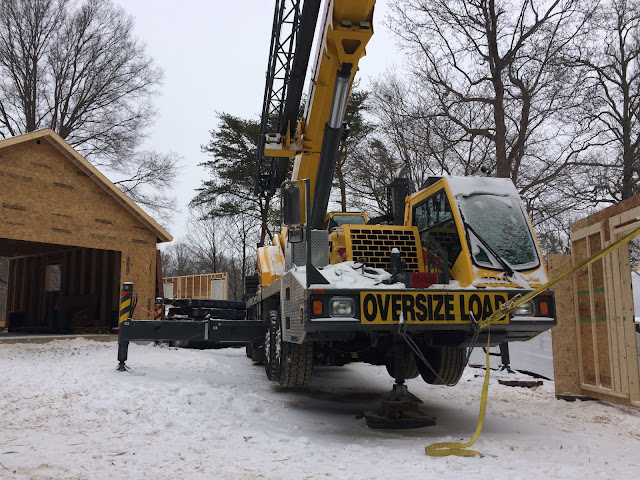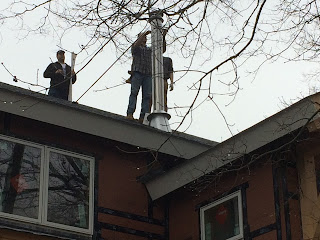Day 11 House Assembly
Saturday, 1/13/18
The rain stopped overnight, so we're able to get going with the crane again. Today, we fly all the porch parts into place. Some of the beams are of a size that we can handle by hand on the ground. But the porch roofs need the crane to handle safely.
The GoPro camera that I use to record the time lapse videos didn't want to stay in one place and kept falling over, even if I clipped it to a tree. So I placed it on the front of the Genie boom lift to get a video of the screened porch roof assembly.
All the timbers are numbered and marked with an arrow to indicate their orientation for assembly. It is just like following the directions for assembling a big doll house ("tab A goes into slot B").
 |
| Porch Timbers with Identification Numbers (H5 and H6 in this case) |
Places where screws are used to tie timbers together are marked to identify the type and length of screw to use. Screws have also evolved. I'm familiar with lag screws, which are basically a big wood screw with a hex head. The structural screws are quite different and do not need a pilot hole to be drilled. The last time I worked with a construction crew, screws were seldom used. That's no longer true with modern construction. Structural screws (known as SDS screws, SPAX, or Timber Lag screws) do not need a pilot hole drilled. It is very helpful to have an impact driver drill though. A regular drill can get whipped around if the screw suddenly stops while the impact driver will simply keep impacting the screw to drive it home. I've never seen so many screws used to build a house.
 |
| Front Entry Porch Roof In Place |
 |
| Dining Screened Porch Roof In Place |
Sadly, today is the last day of the crane. The crane operator was kind enough to let me sit in the operator's seat and teach me a bit about how the controls work. I wasn't willing to lift anything for real, but played around for a few minutes. It must be interesting to hoist a big load that you can't see, relying simply on hand commands from someone who can see the load. We've sometimes had to have a relay person located where the crane operator can see the hand signals. The operator console is an electronic display that shows boom extension, cable length deployed, boom angle, and distance of the hook from the crane itself. The cable up/down control ticks as the hook goes up or down, providing feedback on how fast the hook is moving. Sometimes we're making very careful placements and it is important to know how to signal the operator to move the hook very slowly. The operator controls are two joysticks and three foot pedals. There are crane certifications, which require 2000 hours of operation as an apprentice to achieve.
 |
| Crane Operator's Console |
 |
| Crane Operator's View of the Hook - Note wiper on the top glass |
Today's time lapse is very short, only 10 seconds long.
Day 11 Time Lapse (0:10)



Comments
Post a Comment